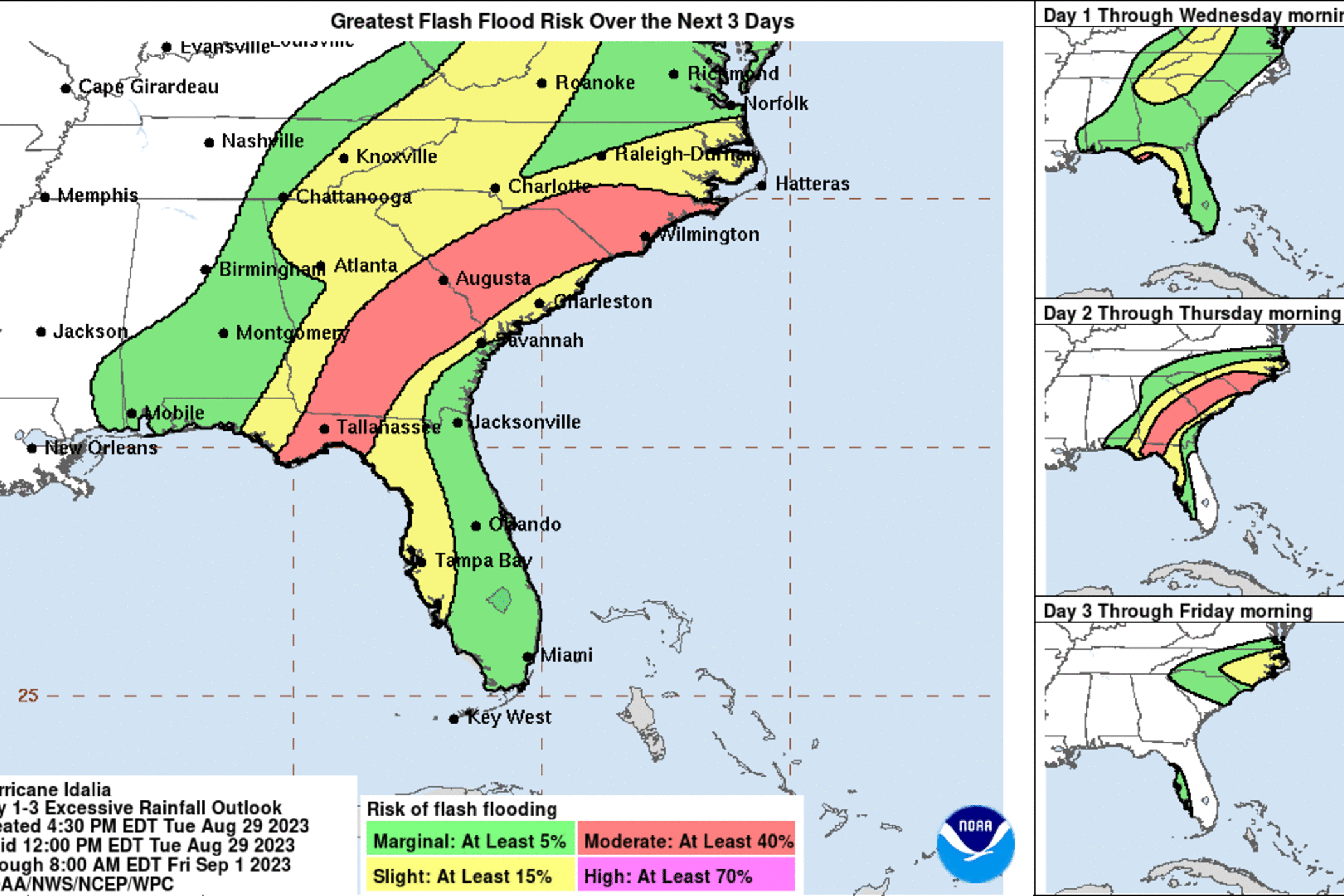Section Branding
Header Content
Hurricane Idalia's threat of flooding is real. Here are four types of floods to be aware of
Primary Content
Hurricane Idalia is expected to make landfall in Florida early Wednesday and bring hurricane and tropical storm conditions to South Georgia Wednesday before heading up the coast of the Carolinas. Visit GPB.org/Storms to make sure you're prepared for this weather event.
Besides high winds and a chance of tornadoes, Idalia will bring lots of moisture and rain to the region. Latest forecasts predict between 2-6 inches of rain or more in the lower part of the state over a 72-hour period.
This means the opportunity for many types of floods to occur.
Flooding is usually divided into two categories. These categories are flash flooding and river flooding. Both of these can cause death, injury, and property destruction.
- Flash floods are usually caused by slow-moving thunderstorms or thunderstorms that move over the same area one after the other, called training. These floods usually occur within 6 hours of heavy rainfall and are usually more life-threatening as a result. Areas most prone to floods are mountainous streams and rivers, urban areas, low-lying areas, and culverts. A good example of flash flooding is the flooding in metropolitan Atlanta in September 2009.
- River flooding is caused by the gradual increase in the water level of a river or creek. These floods usually occur seasonally with general rains or with heavy rainfall from tropical systems. A good example of river flooding is the flooding that affected South Georgia after Tropical Storm Alberto in 1994
But there are other forms of flooding as well — and these are the types of floods that can happen quickly in a tropical storm or hurricane:
- Urban flooding is the flooding of streets, underpasses, low-lying areas, or storm drains. It doesn't happen only in big cities but wherever paved surfaces can't handle the fast accumulation of rain. The National Weather Service says this type of flooding is mainly an inconvenience and is generally not life-threatening. However, the effects of tropical storms can bring unusual amounts of rainfall to these areas, making some roadways impassable, and the inland flood threat is often underemphasized during a tropical event. Typically, greater rainfall amounts and flooding are associated with tropical cyclones that have a slow forward speed or stall over an area.
- Storm surge is a particular problem directly along the coast. Entire coastlines can be altered by the sheer magnitude of the water battering the shores. Storm surge can also travel several miles inland, causing additional flooding and destruction. The addition of intense rainfall along the coast can add to the flooding potential. It is important to note that surge-related fatalities have been greatly reduced due to improved evacuation practices in coastal areas. However, since the 1970s, inland flooding has been responsible for more than half of the deaths associated with tropical cyclones in the United States.
Flooding kills more people than any other weather hazard. The majority of deaths from flooding occur when people become trapped in automobiles that stall while driving through flooded areas. Nearly half of all flood fatalities are vehicle-related. Click here to learn how to prepare.
Tips for staying safe:
- Stay informed: Listen to radio and TV outlets, including NOAA Weather Radio, check the Internet and social media for information and updates as well.
- Get to higher ground: If you live in a flood-prone area or are camping in a low-lying area, get to higher ground immediately.
- Obey evacuation orders: If told to evacuate, do so immediately. Lock your home when you leave. If you have time, disconnect utilities and appliances.
- Avoid areas subject to sudden flooding.
- Turn around, don't drown! Do not attempt to drive over a flooded road. STOP! Turn around and go another way.
- Even just 6 inches of fast-moving floodwater can knock you off your feet, and a depth of 2 feet will float your car. Never try to walk, swim or drive through such swift water.
This article was prepared with resource material and language from the National Weather Service and the Centers for Disease Control and Prevention.


